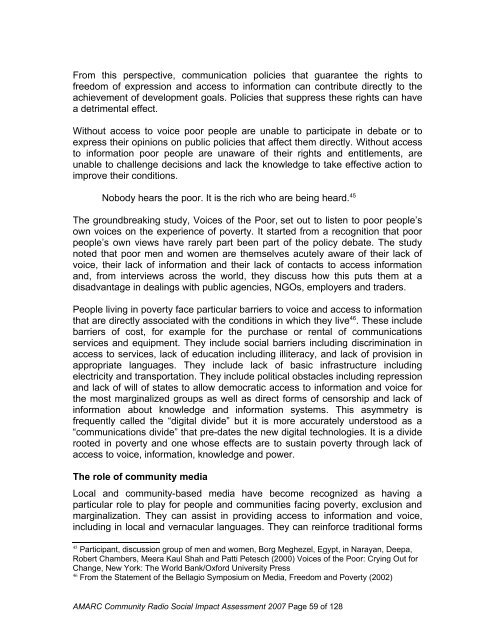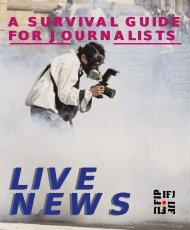Removing Barriers, Increasing Effectiveness - amarc
Removing Barriers, Increasing Effectiveness - amarc
Removing Barriers, Increasing Effectiveness - amarc
You also want an ePaper? Increase the reach of your titles
YUMPU automatically turns print PDFs into web optimized ePapers that Google loves.
From this perspective, communication policies that guarantee the rights tofreedom of expression and access to information can contribute directly to theachievement of development goals. Policies that suppress these rights can havea detrimental effect.Without access to voice poor people are unable to participate in debate or toexpress their opinions on public policies that affect them directly. Without accessto information poor people are unaware of their rights and entitlements, areunable to challenge decisions and lack the knowledge to take effective action toimprove their conditions.Nobody hears the poor. It is the rich who are being heard. 45The groundbreaking study, Voices of the Poor, set out to listen to poor people’sown voices on the experience of poverty. It started from a recognition that poorpeople’s own views have rarely part been part of the policy debate. The studynoted that poor men and women are themselves acutely aware of their lack ofvoice, their lack of information and their lack of contacts to access informationand, from interviews across the world, they discuss how this puts them at adisadvantage in dealings with public agencies, NGOs, employers and traders.People living in poverty face particular barriers to voice and access to informationthat are directly associated with the conditions in which they live 46 . These includebarriers of cost, for example for the purchase or rental of communicationsservices and equipment. They include social barriers including discrimination inaccess to services, lack of education including illiteracy, and lack of provision inappropriate languages. They include lack of basic infrastructure includingelectricity and transportation. They include political obstacles including repressionand lack of will of states to allow democratic access to information and voice forthe most marginalized groups as well as direct forms of censorship and lack ofinformation about knowledge and information systems. This asymmetry isfrequently called the “digital divide” but it is more accurately understood as a“communications divide” that pre-dates the new digital technologies. It is a dividerooted in poverty and one whose effects are to sustain poverty through lack ofaccess to voice, information, knowledge and power.The role of community mediaLocal and community-based media have become recognized as having aparticular role to play for people and communities facing poverty, exclusion andmarginalization. They can assist in providing access to information and voice,including in local and vernacular languages. They can reinforce traditional forms45Participant, discussion group of men and women, Borg Meghezel, Egypt, in Narayan, Deepa,Robert Chambers, Meera Kaul Shah and Patti Petesch (2000) Voices of the Poor: Crying Out forChange, New York: The World Bank/Oxford University Press46From the Statement of the Bellagio Symposium on Media, Freedom and Poverty (2002)AMARC Community Radio Social Impact Assessment 2007 Page 59 of 128
















